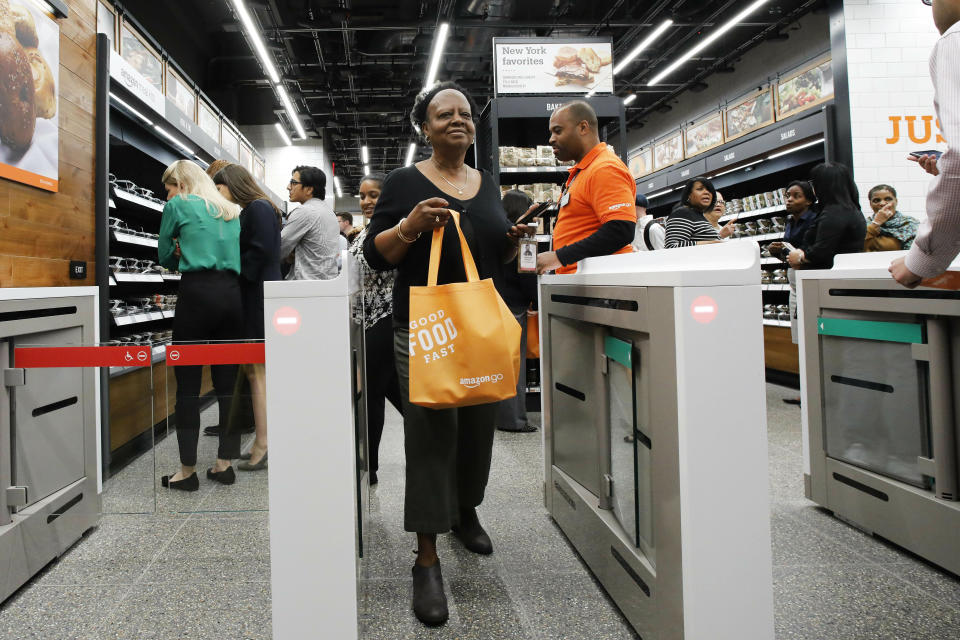How Amazon, scourge of physical retailers, is doubling down on physical retail
Amazon brought its cashier-less Amazon Go store concept to New York City on Tuesday, with a twist—this Go store accepts cash.
It is the 12th Amazon Go store in the U.S., the first in New York, and the first to accept cash. And Amazon plans to start accepting cash at all the other Go stores too.
The shift to accepting cash at stores where the entire tagline is “No lines, no checkout, just walk out shopping” may look contradictory, but it is a response to a growing national backlash against cashless stores. Massachusetts and New Jersey require brick-and-mortar stores to accept cash. San Francisco this month voted to require stores to take cash. New York City is considering the same thing. Critics of cashless stores say cashless discriminates against the underbanked or unbanked. Coffee shop Blue Stone Lane and burrito chain Dos Toros are still cashless, but salad chain Sweetgreen recently flipped back to taking cash.
Amazon’s quick shift to take cash at stores where the whole point was speed and lack of friction is Exhibit A in its broader approach to brick-and-mortar: the company is experimenting and iterating, quickly adapting and willing to change its strategy. And Amazon wants to do much more in brick-and-mortar, not less.
Pushing bigger into brick-and-mortar
Suddenly the internet company once seen as brick-and-mortar’s worst nightmare is making a concerted push into brick-and-mortar. Amazon has 34 total physical stores across America: 18 Amazon Bookstores, 12 Amazon Go stores, and three Amazon 4-Star stores. If you add Whole Foods, that’s another 499 Amazon-owned stores.

Only a few months ago, Amazon had 87 pop-up kiosks in shopping malls across the country. In March, it abruptly announced it would close all of them. It was a sign that Amazon is quickly applying lessons from its various store concepts and shutting down inefficiencies—it is classic Jeff Bezos. And the speed at which Amazon can snap its fingers and shut down 87 pop-up shops sharply contrasts with older brick-and-mortar department stores, for whom shutting down stores is often a months-long protracted process.
Some might ask why Amazon needs so many physical stores. But the strategy here is becoming clear: use all of the stores, even despite their distinct concepts, as distribution centers and showrooms. It is a kitchen sink approach. The bookstores also sell devices like Amazon Echo. Whole Foods stores sell the Echo, too. 4-star stores sell a loosely curated hodgepodge of items with 4-star ratings or higher on the site—plus some items that are too new to have enough ratings yet, plus some snacks.
What Amazon could do next with its store concepts
Considering the way Amazon uses each physical store to merge everything it sells, D.A. Davidson analyst Tom Forte’s prediction back in January was an easy one: “I’m of the belief that five years from now, when you enter Whole Foods, there could be a pharmacy; they could devote the portion of Whole Foods today where you get prepared foods to leveraging the Amazon Go cashierless checkout; and increasingly they can deliver from the store.” Amazon can use each store location to do a little bit of everything.
Amazon reportedly wants to have 3,000 Go stores open by 2021. If that timeline sounds implausible given that it only has 12 Go stores right now, go back and look at how quickly Amazon turned Amazon Web Services into its profit juggernaut, making $7.27 billion in 2018 on $25.65 billion in sales. Amazon (usually) moves extremely fast—its slightly more cautious approach to changes at Whole Foods stores has been an exception.
And if opening more Amazon Go stores isn’t enough, Gene Munster of Loup Ventures predicts Amazon will also start licensing the Go technology to other, non-Amazon retail chains.
With its store footprint multiplying quickly, it can no longer be said that Amazon is “dipping a toe in” to brick-and-mortar retail. The company born on the internet is determined to have a sizable footprint in physical shopping as well.
—
Daniel Roberts is a senior writer at Yahoo Finance and closely covers Amazon. Follow him on Twitter at @readDanwrite.
How Amazon could soon transform Whole Foods
Nashville is the unexpected third-place winner in Amazon HQ2
Manhattan store owner: ‘Amazon is a monster’ that will ‘destroy swaths of the country’

